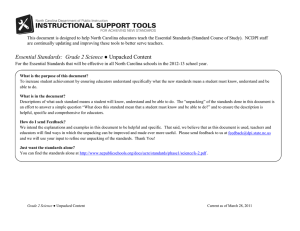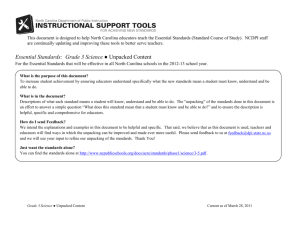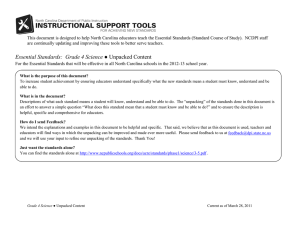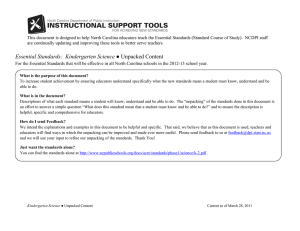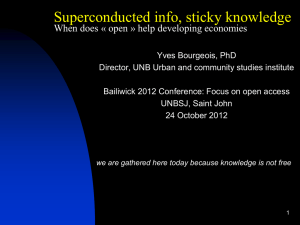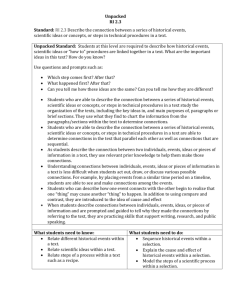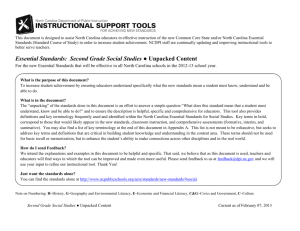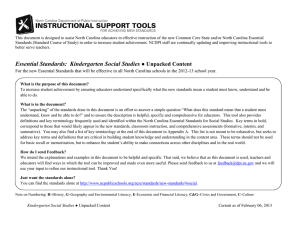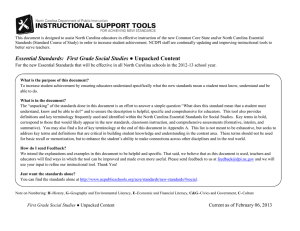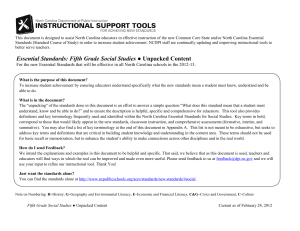Document 10701147
advertisement
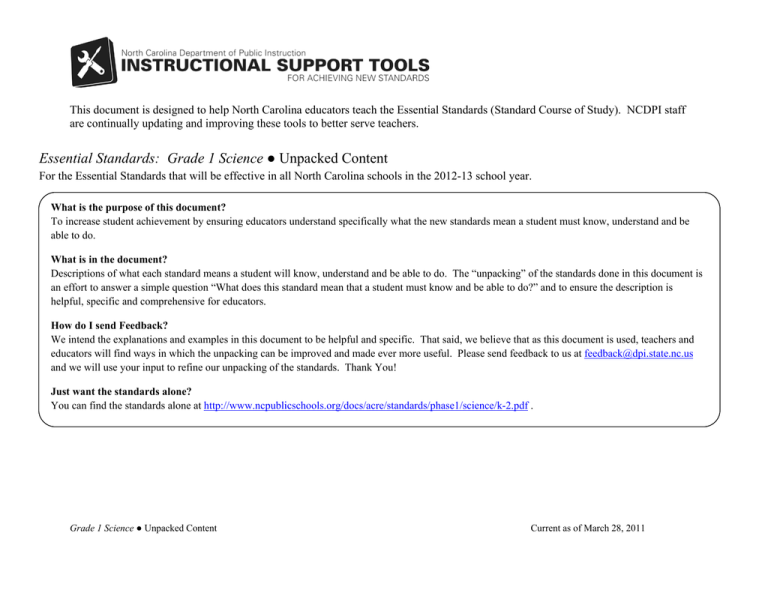
This document is designed to help North Carolina educators teach the Essential Standards (Standard Course of Study). NCDPI staff are continually updating and improving these tools to better serve teachers. Essential Standards: Grade 1 Science ● Unpacked Content For the Essential Standards that will be effective in all North Carolina schools in the 2012-13 school year. What is the purpose of this document? To increase student achievement by ensuring educators understand specifically what the new standards mean a student must know, understand and be able to do. What is in the document? Descriptions of what each standard means a student will know, understand and be able to do. The “unpacking” of the standards done in this document is an effort to answer a simple question “What does this standard mean that a student must know and be able to do?” and to ensure the description is helpful, specific and comprehensive for educators. How do I send Feedback? We intend the explanations and examples in this document to be helpful and specific. That said, we believe that as this document is used, teachers and educators will find ways in which the unpacking can be improved and made ever more useful. Please send feedback to us at feedback@dpi.state.nc.us and we will use your input to refine our unpacking of the standards. Thank You! Just want the standards alone? You can find the standards alone at http://www.ncpublicschools.org/docs/acre/standards/phase1/science/k-2.pdf . Grade 1 Science ● Unpacked Content Current as of March 28, 2011 2 Forces and Motion Essential Standard and Clarifying Objectives 1.P.1 Understand how forces (pushes or pulls) affect the motion of an object. 1.P.1.1 Explain the importance of a push or pull to changing the motion of an object. 1.P.1.2 Explain how some forces (pushes and pulls) can be used to make things move without touching them, such as magnets. 1.P.1.3 Predict the effect of a given force on the motion of an object, including balanced forces. Unpacking What does this standard mean a child will know, understand and be able to do? 1.P.1.1 Students know a force is a push or pull. Students know a force, a push or a pull, can change the motion of an object in three ways: go faster, slower or change the direction of the motion. Students know a force (push or pull) is needed to start objects moving, keep objects moving or stop objects that are moving. 1.P.1.2 Students know magnets exert an unseen force that makes some things move without touching them. Students know magnets have poles that attract or repel each other. 1.P.1.3 Students know the size of the change in motion of an object is based on the amount of force applied to the object. Students know that balance is associated with position and weight. Grade 1 Science ● Unpacked Content Current as of March 28, 2011 3 Earth in the Universe Essential Standard and Clarifying Objectives 1.E.1 Recognize the features and patterns of the earth/moon/sun system as observed from Earth. 1.E.1.1 Recognize differences in the features of the day and night sky and apparent movement of objects across the sky as observed from Earth. 1.E.1.2 Recognize patterns of observable changes in the Moon’s appearance from day to day. Unpacking What does this standard mean a child will know, understand and be able to do? 1.E.1.1 Students know that objects in the sky have patterns of movement. Students know the sun is a star that can only be seen in the daytime, but the moon can be seen sometimes at night and sometimes during the day. Students know there are more stars in the sky than anyone can count, but they are not scattered evenly, and they are not all the same in brightness or color. Students know the sun, moon and stars all appear to move slowly across the sky. 1.E.1.2 Students know the moon looks a little different every day but looks the same again about every four weeks. They know that the moon’s observable changes follow a pattern. Grade 1 Science ● Unpacked Content Current as of March 28, 2011 4 Earth Systems, Structures and Processes Essential Standard and Clarifying Objectives 1.E.2 Understand the physical properties of Earth materials that make them useful in different ways. 1.E.2.1 Summarize the physical properties of earth materials, including rocks, minerals, soils and water that make them useful in different ways. 1.E.2.2 Compare the properties of soil samples from different places relating their capacity to retain water, nourish and support the growth of certain plants. Unpacking What does this standard mean a child will know, understand and be able to do? 1.E.2.1 Students know earth materials include solid rocks, soil and water, which all have different observable properties. Students know from prior experiences that earth materials (matter) may be described by their physical properties (e.g., color, size, shape, weight, texture, flexibility, attraction to magnets, floating or sinking in water). Students know that earth materials that retain their shape regardless of the container they occupy are classified as solids. Students know that water is an Earth material that takes the shape of the container it occupies and is classified as a liquid. Students know that earth materials have different properties that sustain plant and animal life. Students know that some Earth materials have properties that make them useful in solving human problems. 1.E.2.2 Students know that soils have different properties based on where they are located on the earth. Students know that some soils retain more water, nutrients and provide better structural support than others and therefore enhance the growth and development of certain plants. Grade 1 Science ● Unpacked Content Current as of March 28, 2011 5 Ecosystems Essential Standard and Clarifying Objectives 1.L.1 Understand characteristics of various environments and behaviors of humans that enable plants and animals to survive. 1.L.1.1 Recognize that plants and animals need air, water, light (plants only), space, food and shelter and that these may be found in their environment. 1.L.1.2 Give examples of how the needs of different plants and animals can be met by their environments in North Carolina or different places throughout the world. 1.L.1.3 Summarize ways that humans protect their environment and/or improve conditions for the growth of the plants and animals that live there (e.g., reuse or recycle products to avoid littering). Unpacking What does this standard mean a child will know, understand and be able to do? 1.L.1.1 Students know that living things need food, water, air; a way to dispose of waste; and an environment in which they can live. Students know animals eat plants or other animals for food and may also use plants (or even other animals) for shelter and nesting. 1.L.1.2 Students know people need water, food, air, waste removal and a particular range of temperatures in their environment, just as other animals (and plants) do. Students know that living things are found almost everywhere in the world. In North Carolina, from the coast to the mountains, students should observe how different environments support the needs of different organisms (crab/seashore, raccoon/piedmont, elk/mountains). There are different kinds of organisms in different places. 1.L.1.3 Students know that humans depend on their natural and constructed environment and that humans can change the natural environment in ways Grade 1 Science ● Unpacked Content Current as of March 28, 2011 6 that are beneficial or detrimental to humans or other living things. Students know that it is beneficial for humans to participate in activities that provide protection for the environment and/or improve the conditions of the environment for the growth of plants and animals that live there. Students know many materials can be recycled and used again, sometimes in different forms. Molecular Biology Essential Standard and Clarifying Objectives 1.L.2 Summarize the needs of living organisms for energy and growth. 1.L.2.1 Summarize the basic needs of a variety of different plants (including air, water, nutrients, and light) for energy and growth. 1.L.2.2 Summarize the basic needs of a variety of different animals (including air, water, and food) for energy and growth. Unpacking What does this standard mean a child will know, understand and be able to do? 1. L.2.1 Students know plants are living things that need energy and grow. Students know plants need to take in water, nutrients and light (to make their own food) for energy and growth. 1. L.2.2 Students know animals are living things that grow and have basic needs for energy, air, and water. Animals depend on plants to provide them with energy directly or indirectly. Animals take in plants or other animals as an energy source. Grade 1 Science ● Unpacked Content Current as of March 28, 2011
